Achieving Absolute Fretboard Mastery, Part 12
Learn how to apply your knowledge of modes effectively across the fretboard.

In this month’s installment of Absolute Fretboard Mastery (which happens to be the final installment), we’ll be going a little bit deeper into the modes we learned last month by learning how to apply them across our fretboard.
But before we get into that, I want to address a common misconception a lot of guitarists have when learning the modes. They think of modes as completely separate entities, as opposed to different aspects of one scale.
This was something that confused me too when I started learning about modes, so I want to make sure we’re absolutely clear on exactly what modes are and how they function.
Let’s start off by taking a look at the first position of the A minor pentatonic we’ve learned:
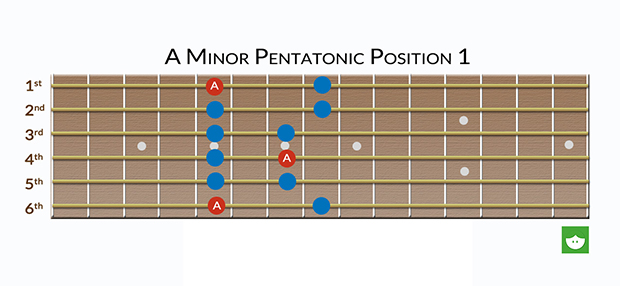
Say we were playing in the key of A minor; the pitches we would emphasize in this first position are the A notes, which are highlighted in the chart above. Of course, there are various other notes we could emphasize on in this position, but as long as the chord is A minor, we stick to emphasizing those A notes.
When we move to the second position of the A minor pentatonic scale, the structure of this position looks different from the first, but as long as we’re playing in the key of A minor, we’d still be trying to find those A notes to emphasize them.
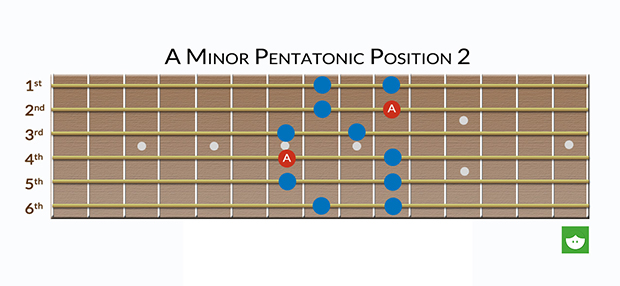
In the same way, as we keep moving through the remaining three positions of the A minor pentatonic scale, we’d keep emphasizing those A notes.
When we move onto the diatonic scale, things can get a bit confusing because sometimes we label the first shape of the diatonic scale as Ionian, the second as Dorian and the third as Phrygian, and so on and so forth. To clear things up, let’s take a look at the first spread-finger shape of the G major scale:
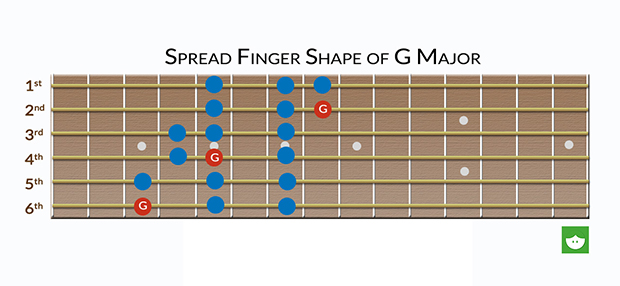
Remember that if you want to change to a different key, you can simply move this shape around. For example, C major would be:
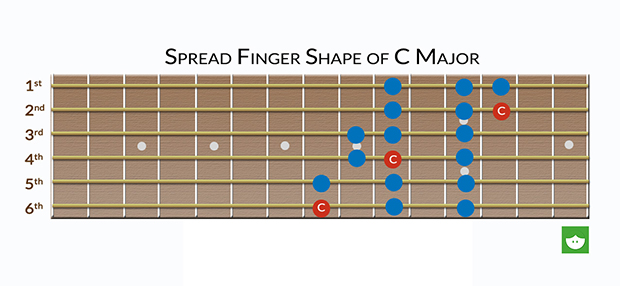
Going back to our example, let’s take a look at the second shape of the G major scale:
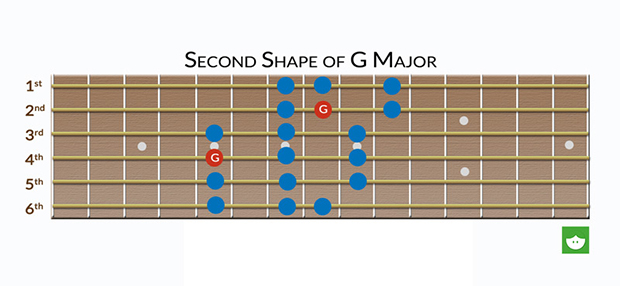
Sometimes people refer to this second position as Dorian. But we know from last month’s lesson that Dorian simply means “two,” and when we say we’re playing in A Dorian, we’re still in the key of G major and simply emphasizing the note A and the chord A minor.
But here’s the thing: Instead of moving to the second position, we can still stay in the first position of G major and target the A notes in that shape.
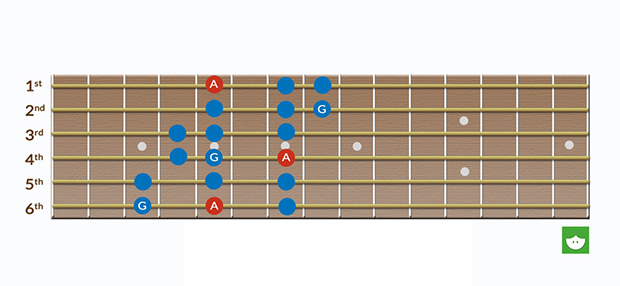
Stop thinking that if you want to play in Dorian you HAVE to move to the second position. Or that if you want to play in Phrygian you HAVE to move to the third position, and so on. Just as the five pentatonic shapes allow you to navigate across your entire fretboard, I want you to internalize the fact that the seven shapes of the diatonic scale allow you to play across your whole fretboard while emphasizing any note you want, in any position you want.
Instead of looking at your fretboard and visualizing the first position as Ionian, the second position as Dorian, the third as Phrygian and so on, work on being able to visualize all seven positions across your fretboard while remembering you also can emphasize whichever note you want across all seven positions.
A good way of approaching this is to first memorize all seven positions of the diatonic scale across the fretboard. You can do this by tackling a couple of positions at a time, then connecting them to each other, the same way we did with the pentatonic scales, until you can connect them across the entire fretboard.
Once you’ve done that, and once you’ve also internalized what we learned in last month’s lesson, when someone says you need to play in G Dorian, all you’ll have to do is understand that you’re really in F major. Move all seven positions to coincide with the key of F and then emphasize the G notes across all the scale shapes.
By doing this, you prevent yourself from falling into the trap of segregating yourself to specific scale shapes when wanting to play in a specific mode. In addition, this helps with your absolute understanding of modes and how they relate to the major scales they are a part of.
Say you need to play in a specific mode; all you need to do is grasp which major scale you’re in, visualize the seven shapes of that scale across your fretboard and then decide on the notes to emphasize across these scale shapes. For instance, if you need to play in D Mixolydian, you need to first understand that you’re in the key of G.
Then you can visualize the seven shapes of the G major scale across your fretboard and finally target and emphasize the D notes in these shapes to play in D Mixolydian. If you’re having trouble spotting the notes across your frets, you might want to revisit some of the earlier lessons in this series where we talked about learning the notes across each string.
As always, I hope you practice hard and work on these concepts until you internalize them. I’ll talk to you soon!
Steve Stine is a longtime and sought-after guitar teacher who is professor of Modern Guitar Studies at North Dakota State University. Over the last 30 years, he has taught thousands of students, including established touring musicians, and released numerous video guitar lesson courses via established publishers. A resident of Fargo, North Dakota, today he is more accessible than ever before through the convenience of live online guitar lessons at Lessonface.com.
Get The Pick Newsletter
All the latest guitar news, interviews, lessons, reviews, deals and more, direct to your inbox!
“There are so many sounds to be discovered when you get away from using a pick”: Jared James Nichols shows you how to add “snap, crackle and pop” to your playing with banjo rolls and string snaps
Don't let chord inversions bamboozle you. It's simply the case of shuffling the notes around







![Joe Bonamassa [left] wears a deep blue suit and polka-dotted shirt and plays his green refin Strat; the late Irish blues legend Rory Gallagher [right] screams and inflicts some punishment on his heavily worn number one Stratocaster.](https://cdn.mos.cms.futurecdn.net/cw28h7UBcTVfTLs7p7eiLe.jpg)


